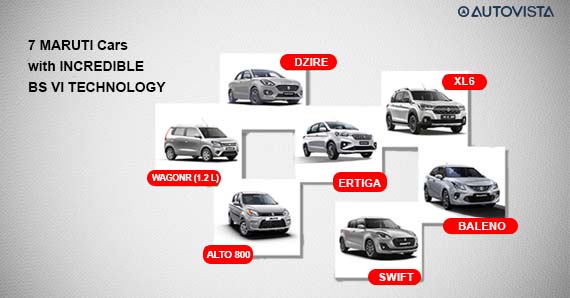
In around seven months, India will fully adopt the stricter BS6 emission standards – a change that can be named as the most significant technological jump the country's auto industry has taken towards clean air. The shift, by skipping BS5, has not just occurred in record time – around three and a half years – yet additionally under high pressure, as both the oil companies and the vehicle business worked steadily to prepare in time for the challenging deadline of April 2020.
In any case, not all automakers have managed how to make this progress sufficiently quick, bringing about numerous models and powertrains being eliminated. It has likewise involved a critical cost, one that will be given to the customer. Usually, the discussion surrounding the shift has brought up numerous issues and left various car buyers flummoxed. But we'll separate it and determine what you have to know.
Maruti Suzuki India Limited proceeded with its trend of being an industry first and turned into the first OEM to bring BS6 compliant vehicles in the mass compliant vehicles, much in front of statutory timelines prescribed by the Indian Government. Maruti Suzuki has upgraded 7 of their oil vehicles to meet BS6 outflow standards, well ahead of the deadline of first April 2020. Accordingly, half of Maruti Suzuki's petroleum scope of cars is currently BS6 compliant. It additionally implies that the BS6 consistent car models offered by Maruti Suzuki at present comprise around 70% of the total petrol vehicles sold, including all vehicle makers.
How will cars be made BS6-compliant?
Automakers generally receive a two dimensional usually, which includes taking a shot at the engine and the after-treatment. Regarding the in-cylinder measures, upgraded burning chamber and fuel injector design will refine the combustion process and result in better atomization of fuel. What's more, then again, the arrivals of releases like PM and NOx is arrested utilizing exhaust treatment systems.
Direct-injection petrol and diesel engines depend on particulate filters to diminish the emission of PM or sediment into the atmosphere. A more significant level of NOx – a test particularly with diesel engines – is handled either by utilizing a Lean NOx Trap (LNT) or a Selective Catalytic Reduction (SCR) system.
As per their commitment to launch environment-friendly vehicles, Maruti Suzuki introduced its first BS6 compliant petrol car, Baleno in April 2019. The most recently launched Multi-Purpose Vehicle (MPV), the new XL6 is the second BS6 compliant Nexa model by Maruti Suzuki. BS6 compliant petrol models by MSIL include industry bestsellers like:
WHICH MARUTI SUZUKI & NEXA CARS ARE BS6 COMPLIANT?
As per commitment to launch environment-friendly vehicles, Maruti Suzuki introduced its first BS6 compliant petrol car, Baleno in April 2019. The most recently launched Multi-Purpose Vehicle (MPV), the new XL6 is the second BS6 compliant Nexa model by Maruti Suzuki.
Following are some BS6 compliant petrol models:

What will be the impact on performance and fuel efficiency?
They are moving to more stringent emission norms posts challenges for automakers in a higher number of ways than one. Bringing down emissions outflows generally brings about a penalty on execution and fuel efficiency. So not exclusively do car manufacturers need to limit pollution. However, they likewise need to proactively progress in the direction of retaining the vehicles' drivability.
Cleaner engines generally utilize a slower combustion process. Also, fumes after treatment systems increase backpressure, and some of these systems, similar to particulate channels and NOx traps, need to undergo regeneration periodically. These variables collectively will, in general, negatively affect the vehicle's exhibition and efficiency. Automakers are receiving changed ways to deal with handle these challenges.
What are the advantages of moving to BS6?
The transition from BS4 to BS6 will bring along a ton of significant advantages. These include: -
• Upgraded engine with the innovative progression of exhaust system guaranteeing a substantial increase in its strength
• BS-VI compliant vehicle motor lessens about 25% Nitrogen Oxides (NOx) emissions in petroleum vehicles and generous 70% on diesel vehicles
• BS-VI norms additionally implement stringent limit on Non-Methane Hydrocarbons (NMHC) emissions
• Another advantage is that On-board Diagnostics, OBD has been made compulsory for all vehicles. This helps in watching that the outflow control segment is working at ideal proficiency consistently. With the OBD unit, one can screen the pollution in real-time.
• RDE (Real Driving Emission) on all vehicles empowers ongoing following of emissions in real-world conditions and not merely test conditions.
• Introduction of DPF (Diesel Particulate Filter) and SCR (Selective Catalytic Reduction) for diesel engines
• Certain new safety features are made compulsory in all BS-VI compliant vehicles
The new emission standard will require both vehicle OEMs and oil and fuel organizations to redesign their items. In a perfect world, for best outcomes, BSVI compliant vehicles should utilize BSVI fuel, as the latest motors running on lower-quality fuel will transmit a significant amount of toxic gases.
Last Words
The automobile industry and oil organizations are through with a share of responsibilities. The ball is currently in the Indian Government's court to redo its vehicle scrap page policy, subsequently ensuring that quality vehicles handle on Indian streets. It is fundamental for the conservation of the condition that the polluting cars go off the roads at the earliest possible.
